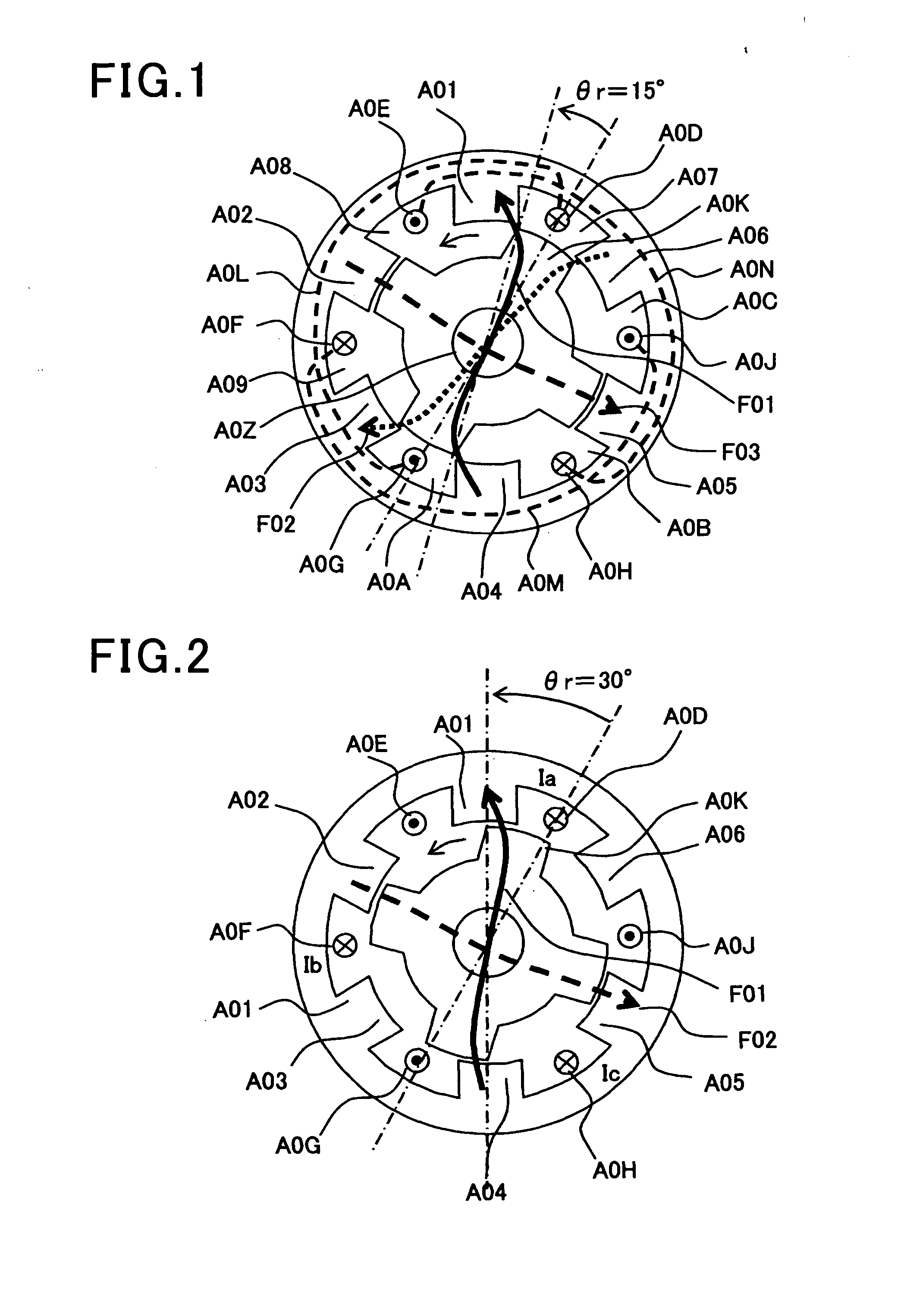Full-pitch windings switched reluctance motor
a technology of switched reluctance motors and windings, which is applied in the direction of motor/generator/converter stoppers, electronic commutators, dynamo-electric converter control, etc., can solve the problems of reducing the efficiency of the use of windings, and affecting the operation of the motor. , to achieve the effect of simple circuitry, higher rotation speed and improved reliability
- Summary
- Abstract
- Description
- Claims
- Application Information
AI Technical Summary
Benefits of technology
Problems solved by technology
Method used
Image
Examples
tenth embodiment
[0367]Hereinafter is specifically described a motor related to a tenth embodiment.
[0368]In FIG. 36, the power conversion sections FE8, FEC and FEG that produce positive voltages as shown in FIG. 35 correspond to transistors FK7, FK8 and FK9. A-phase power conversion sections corresponding to the power conversion sections FE9, FED and FEH that produce negative voltages as shown in FIG. 35, are provided by the combinations of a diode FKD and resistor FK4, a Zener diode FKG, a transistor FKA and the like. When the transistor FK7 is turned off, the A-phase current Ia passes through an A-phase winding 87D. The A-phase current Ia is supplied to the elements FK4, FKG and FKA. Thus, the magnetic energy in the A-phase winding 87D is consumed to thereby reduce the A-phase current Ia. In this case, the resistance of the resistor FK4, the voltage of the Zener diode FKG and the like are determined, so that the voltage generated across the resistor FK4 will be smaller than the voltage of the powe...
eleventh embodiment
[0371]Hereinafter is specifically described a motor related to an eleventh embodiment.
[0372]FIG. 37 shows a configuration in which two A-phase windings FL1 and FL4 are provided to the same slot and these windings are connected in series. Schematically, the windings are arranged as shown in FIG. 16. The two windings in the same slot may be may be provided as so-called bifilar windings in which two windings are wound in parallel, so that interlinked magnetic flux is shared therebetween as much as possible. In FIG. 37, the power conversion section FE8 that produces the A-phase positive voltage in FIG. 35 corresponds to transistors FLA and FLB. When these transistors are turned on, the voltage Vs of the power supply 87G is applied to the winding FL1.
[0373]The power conversion section FE9 that produces negative voltage corresponds, in FIG. 37, to the off control action of the transistors FLA and FLB and the voltage division performed by diodes FLG and FLH and the windings FL1 and FL4. Wh...
twelfth embodiment
[0377]Hereinafter is specifically explained a motor related to a twelfth embodiment.
[0378]FIG. 38 shows a configuration in which the control circuit shown in FIG. 9 is additionally provided with a power supply 84D. Further, connection destinations of the collectors of the transistors 871, 873 and 875 are changed to the positive side of the power supply 84D. With this configuration, a voltage VFD used in increasing the current of each phase winding is ensured to be larger than a voltage VBD used in decreasing the current of each phase winding. The voltage difference is equivalent to the voltage of the power supply 84D. Thus, when the current is decreased, the influence on the voltage given to other phases is ensured to be reduced.
PUM
 Login to View More
Login to View More Abstract
Description
Claims
Application Information
 Login to View More
Login to View More - R&D
- Intellectual Property
- Life Sciences
- Materials
- Tech Scout
- Unparalleled Data Quality
- Higher Quality Content
- 60% Fewer Hallucinations
Browse by: Latest US Patents, China's latest patents, Technical Efficacy Thesaurus, Application Domain, Technology Topic, Popular Technical Reports.
© 2025 PatSnap. All rights reserved.Legal|Privacy policy|Modern Slavery Act Transparency Statement|Sitemap|About US| Contact US: help@patsnap.com



